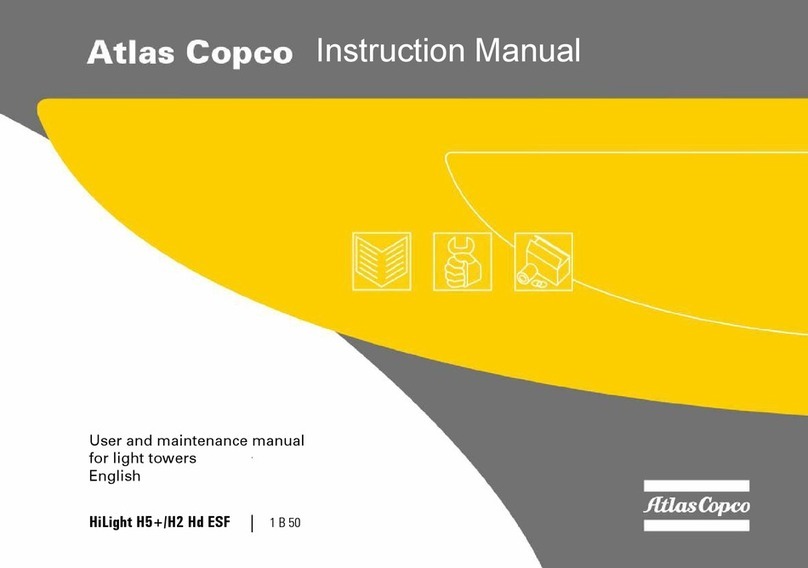
- 12 -
1.4 Safety during use and
operation
1. Periodically carry out maintenance works
according to the maintenance schedule.
2. Stationary housing guards are provided on all
rotating or reciprocating parts not otherwise
protected and which may be hazardous to
personnel. Machinery shall never be put into
operation, when such guards have been removed,
before the guards are securely reinstalled.
3. When the sound pressure level, at any point where
personnel normally has to attend, is:
- below 70 dB(A): no action needs to be taken,
- above 70 dB(A): noise-protective devices should
be provided for people continuously being
present in the room,
- below 85 dB(A): no action needs to be taken for
occasional visitors staying a limited time only,
- above 85 dB(A): room to be classified as a noise-
hazardous area and an obvious warning shall be
placed permanently at each entrance to alert
people entering the room, for even relatively
short times, about the need to wear ear
protectors,
- above 95 dB(A): the warning(s) at the
entrance(s) shall be completed with the
recommendation that also occasional visitors
shall wear ear protectors,
- above 105 dB(A): special ear protectors that are
adequate for this noise level and the spectral
composition of the noise shall be provided and a
special warning to that effect shall be placed at
each entrance.
4. Never operate the unit in surroundings where
there is a possibility of taking in flammable or
toxic fumes.
5. If the working process produces fumes, dust or
vibration hazards, etc., take the necessary steps to
eliminate the risk of personnel injury.
6. When using compressed air or inert gas to clean
down equipment, do so with caution and use the
appropriate protection, at least safety glasses, for
the operator as well as for any bystander. Do not
apply compressed air or inert gas to your skin or
direct an air or gas stream at people. Never use it
to clean dirt from your clothes.
7. When washing parts in or with a cleaning solvent,
provide the required ventilation and use
appropriate protection such as a breathing filter,
safety glasses, rubber apron and gloves, etc.
8. Safety shoes should be compulsory in any
workshop and if there is a risk, however small, of
falling objects, wearing of a safety helmet should
be included.
9. If there is a risk of inhaling hazardous gases,
fumes or dust, the respiratory organs must be
protected and depending on the nature of the
hazard, so must the eyes and skin.
10. Remember that where there is visible dust, the
finer, invisible particles will almost certainly be
present too; but the fact that no dust can be seen is
not a reliable indication that dangerous, invisible
dust is not present in the air.
11. Never operate the light tower in excess of its limits
as indicated in the technical specifications and
avoid long no-load sequences.
12. Never operate the light tower in a humid
atmosphere. Excessive moisture causes
worsening of the light tower insulation.
13. Do not open electrical cabinets, cubicles or other
equipment while voltage is supplied. If such
cannot be avoided, e.g. for measurements, tests or
adjustments, have the action carried out by a
qualified electrician only, with appropriate tools,
and ascertain that the required bodily protection
against electrical hazards is applied.
14. Never touch the power terminals during operation
of the machine.
15. Whenever an abnormal condition arises, e.g.
excessive vibration, noise, odour, etc., switch the
circuit breakers to OFF. Correct the faulty
condition before restarting.
16. Check the electric cables regularly. Damaged
cables and insufficient tightening of connections
may cause electric shocks. Whenever damaged
wires or dangerous conditions are observed,
switch the circuit breakers to OFF and stop the
unit. Replace the damaged wires or correct the
dangerous condition before restarting. Make sure
that all electric connections are securely
tightened.
00_00_HiLight E2–E3+_9L.book Page 12 Friday, October 12, 2018 11:34 AM

































